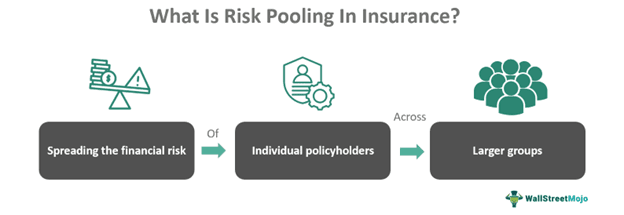Table of Contents
Risk Pooling In Insurance Definition
Risk pooling in insurance is a risk management strategy in which all the insurance companies form a shared pool used as protection against catastrophic events and natural disasters. Apart from the insurance industry, a risk pool is commonly used by government agencies for the same purpose.

By creating a risk pool, all the insurance companies come together to share the expected risk. This way, the participants do not transfer the risk to someone else, but each company reduces its own risk. It offsets the cost of high-risk customers compared to those who have low-risk profiles.
Key Takeaways
- Risk pooling in insurance is a technique to mitigate risk by forming a shared pool with the help of all companies.
- It is not limited to insurance companies but is often practiced by government agencies and car insurance providers. The pool protects the companies against natural disasters and global calamities.
- There are typically four types: self-insurance, captive insurance, group insurance, and reinsurance.
- The entire risk pool is created only after all the participants agree to the rules and regulations and adhere to the principles of risk pooling.
Risk Pooling In Insurance Explained
Risk pooling in insurance is a process of distributing the risk by creating a shared pool of multiple organizations or individual policyholders. When it is initiated, it minimizes the overall risk exposure. The whole concept relies on the fact that no one entity is responsible or burdened with the total cost of losses; instead, each participant in the pool is touched by it. Although government agencies and car insurance providers use it, it is prominently seen in the insurance industry to create protection against risks from catastrophic events and natural disasters.
There are four types of risk pooling in insurance -
- Self-insurance - It happens that instead of purchasing insurance, a company or individual keeps a certain amount of funds aside to cover potential losses.
- Captive insurance - Here, the company creates its own insurance company to take care of its risks and offer coverage.
- Group insurance - In this scenario, a group of organizations or individuals collaborate to buy insurance as a single entity.
- Reinsurance - This occurs when an insurer transfers some of its risk to another insurance company.
Generally, these risk pools are of high value and cover thousands of policyholders to ensure they are not being overcharged in times of crisis. At the same time, from the insurer’s perspective, these pools help them be prepared for any unfortunate events. It is one of the core principles of risk pooling that the funds must only be used for unpredictable and natural events and not for routine purposes.
Exploring insurance options can help you find coverage that fits your unique needs. For those interested in comparing a range of insurance products, resources like SuperMoney make it easier to review and select policies from top providers.
Examples
Below are some hypothetical and real-world examples to help one understand the concept better.
Example #1
Suppose there is a fictional insurance company called New Life Insurance Company. It has 9000 policyholders paying an average of $450 premium annually. It means that the company will have approximately $4050000 in total premiums to cover any potential losses. For example, suppose all of them participate in a risk pool created for a natural disaster or extreme weather event.
Suppose nine policyholders together face a covered catastrophic event that brings a total of $4050 in claims. In that case, the company can use the $4050000 to make up for those losses without requiring affected policyholders to pay the total cost themselves. In this way, risk pooling assists by combining the total premiums paid by a large group to cover the losses of those who collectively suffered an unfortunate event.
Example #2
In 2021, the Indonesian government launched a new disaster risk pooling facility with an initial capacity of $500 million to help pay for the economic costs of natural catastrophes and other weather-related events. The risk pool is also created with the objective of shifting most of the risk to private insurers and other capital market sources.
The pool was designed after a lengthy discussion that lasted a couple of years with the World Bank and other global organizations. This risk pool is essential for Indonesia as the country suffers between $1.3 billion and $1.5 billion in economic damages annually from natural disasters.
The World Bank also discussed the use of catastrophe bonds with the government of Indonesia, and the Joint Fund for Disaster Management, also known as the Disaster Pooling Fund, was launched parallel to the risk pool by the government.
Advantages & Disadvantages
The advantages of risk pooling in insurance are -
- The foremost benefit of risk pooling is sharing risk. With the help of risk pooling, the financial impact is distributed by all the insurers and participants of the entire pool.
- Risk pooling assists in minimizing the burden of individual policyholders and serves as a protection for them against unexpected events.
- Insurance policies have become more affordable and accessible for individual policyholders through risk pooling.
- Insurers tend to create a more significant risk pool; the larger the risk pool, the less loss affected the companies become, and losses become predictable.
- With the help of risk pooling, insurance companies diversify their risk portfolio among different policyholders, coverage types, geographic locations, and other aspects.
The disadvantages of risk pooling in insurance are -
- Risk pooling often comes with limited customization and features; this means that it may only provide tailor-made coverage to some individual insurance policies.
- It creates a moral hazard as both the insurer and insuree have to take more risk compared to a scenario where they were entirely responsible for the cost of losses.
- In a risk pool, there is negligible control, and individuals and insurance companies have less authority over coverage and claim procedures.
Disclosure: This article contains affiliate links. If you sign up through these links, we may earn a small commission at no extra cost to you.

